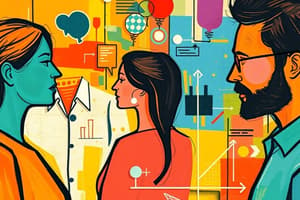Podcast
Questions and Answers
What characterizes a straight rebuy situation?
What characterizes a straight rebuy situation?
- The buyer seeks a complete solution from multiple sellers.
- The buyer purchases for the first time.
- The buyer reorders without changing anything. (correct)
- The buyer modifies the order specifications.
Which factor is NOT part of the adoption process for innovation?
Which factor is NOT part of the adoption process for innovation?
- Relative advantage
- Communication capacity
- Brand loyalty (correct)
- Compatibility
In business buying behavior, which aspect does NOT typically increase complexity compared to consumer purchases?
In business buying behavior, which aspect does NOT typically increase complexity compared to consumer purchases?
- More professional purchasing effort
- Limited supplier interactions (correct)
- More buyer and seller interaction
- More decision participants
Which term describes a buying situation where the buyer seeks to modify the product specifications or terms?
Which term describes a buying situation where the buyer seeks to modify the product specifications or terms?
What role is primarily responsible for controlling the flow of information in the business buying process?
What role is primarily responsible for controlling the flow of information in the business buying process?
What does consumer buyer behaviour primarily refer to?
What does consumer buyer behaviour primarily refer to?
Which of the following is NOT a source of data regarding consumer behaviour?
Which of the following is NOT a source of data regarding consumer behaviour?
What is a reference group in the context of consumer behaviour?
What is a reference group in the context of consumer behaviour?
Which of the following best describes an opinion leader?
Which of the following best describes an opinion leader?
Which factor does NOT influence consumer buying behaviour?
Which factor does NOT influence consumer buying behaviour?
What is the primary goal of Marketing Analytics in understanding consumer behaviour?
What is the primary goal of Marketing Analytics in understanding consumer behaviour?
Which of the following represents ethical considerations in consumer data management?
Which of the following represents ethical considerations in consumer data management?
Which of the following best defines motivation?
Which of the following best defines motivation?
What is selective attention?
What is selective attention?
In the buyer decision process, what occurs during the need recognition phase?
In the buyer decision process, what occurs during the need recognition phase?
Which source of information is NOT typically considered a commercial source?
Which source of information is NOT typically considered a commercial source?
How do consumers typically handle selective distortion?
How do consumers typically handle selective distortion?
What can contribute to selective retention?
What can contribute to selective retention?
During the evaluation of alternatives, how do consumers typically view products?
During the evaluation of alternatives, how do consumers typically view products?
Which of the following statements about beliefs and attitudes is true?
Which of the following statements about beliefs and attitudes is true?
What role does perception play in consumer behavior?
What role does perception play in consumer behavior?
What is the purpose of the information search stage in the buyer decision process?
What is the purpose of the information search stage in the buyer decision process?
Flashcards
Consumer Buyer Behaviour
Consumer Buyer Behaviour
Refers to the way individuals and households purchase goods and services for their personal use.
Consumer Market
Consumer Market
All the individuals and households who buy goods and services for personal consumption.
Consumer Data Sources
Consumer Data Sources
The data collected from online interactions, mobile devices, e-commerce platforms, Internet of Things (IoT) devices, surveys, physical stores, cookies, and third-party sources.
Subculture
Subculture
Signup and view all the flashcards
Reference Group
Reference Group
Signup and view all the flashcards
Opinion Leader
Opinion Leader
Signup and view all the flashcards
Psychographics
Psychographics
Signup and view all the flashcards
Purchase Decision
Purchase Decision
Signup and view all the flashcards
Adoption Process
Adoption Process
Signup and view all the flashcards
Business Buyer Behaviour
Business Buyer Behaviour
Signup and view all the flashcards
Straight Rebuy
Straight Rebuy
Signup and view all the flashcards
Modified Rebuy
Modified Rebuy
Signup and view all the flashcards
Consumer Buying Behavior
Consumer Buying Behavior
Signup and view all the flashcards
Personality
Personality
Signup and view all the flashcards
Motivation
Motivation
Signup and view all the flashcards
Perception
Perception
Signup and view all the flashcards
Learning
Learning
Signup and view all the flashcards
Beliefs
Beliefs
Signup and view all the flashcards
Attitudes
Attitudes
Signup and view all the flashcards
Selective Distortion
Selective Distortion
Signup and view all the flashcards
Selective Retention
Selective Retention
Signup and view all the flashcards
Selective Attention
Selective Attention
Signup and view all the flashcards
Study Notes
Consumer Buyer Behavior
- Consumer buyer behavior is the process individuals and households undergo when purchasing goods and services for personal consumption.
- Consumer markets encompass all individuals and households buying goods/services for personal use.
- Data sources for consumer behavior include online interactions (digital traces), mobile devices (location data, app use), e-commerce, IoT devices, surveys, physical stores, cookies/tracking, and third-party sources.
- Data is collected, analyzed, visualized, and used for action. CRM platforms integrate and analyze data for a 360-degree view.
- Ethical considerations regarding consumer data include privacy, data security, data protection, and misuse of data.
Sources of Consumer Data
- Online interactions (browsing, purchasing, social media) form a digital trace.
- Mobile devices provide location data, app usage, and biometric information.
- E-commerce reveals purchase history and preferences.
- IoT devices track user habits and preferences.
- Surveys and feedback gather customer opinions.
- Physical stores use loyalty programs, cameras, and sensors for data collection.
- Cookies and tracking monitor online behavior (time spent, page views, item additions).
- Third-party sources offer demographic, income, and psychographic data.
Cultural Influences
- Culture is a set of values, perceptions, and behaviors learned from family and institutions.
- Subcultures are groups within a culture sharing values based on experiences.
- Reference groups serve as comparison points for behavior.
- Opinion leaders have influence based on skills, knowledge, personality or characteristics.
- Word-of-mouth influence comes from recommendations of trusted individuals.
Buyer's Black Box
- The 'buyer's black box' illustrates the decision-making process between marketing stimuli and buyer responses.
- Buyers' characteristics include economic, technological, social, and cultural factors.
- Buyer decision processes involve need recognition, information search, evaluation of alternatives, purchase decision, and post-purchase behavior.
Buyer Responses
- Buying attitudes and preferences are shaped by factors.
- Purchase behavior includes what, when, where, and how much is bought.
- Brand engagement and relationships are built through experiences.
Types of Buying Decision Behavior
- Need recognition: buyer recognizes a difference between actual and desired state.
- Information search: motivated buyer gathers information from personal, commercial, public, and personal sources.
- Evaluation of alternatives: buyer assesses product attributes and brand beliefs.
- Purchase decision: forming preference and making purchase decisions. Includes attitudes of others and unforeseen factors.
- Post-purchase behavior: perceived value, satisfaction (or dissatisfaction) affects future actions.
Business Buyer Behavior
- Business buyer behavior involves organizations purchasing goods and services to use in production.
- Purchasing processes involve determining product/service needs, evaluating alternatives, and choosing among brands.
- Business buying usually involves more participants and formal procedures than consumer buying.
Adoption Process
- The adoption process describes the steps an individual goes through from learning about an innovation to adopting it. Stages include: consciousness, interest, evaluation, trial, and adoption.
- Factors influencing adoption include relative advantage, compatibility, complexity, divisibility, and communication capacity.
Influencer Marketing
- Established influencers spread brand information (usually positive).
- Roles and status influence buying behavior.
- Factors like occupation, age, and lifestyle affect buying decisions.
- Economic factors (income, savings, interest rates) impact purchasing habits.
Selective Processes
- Selective attention is screening out most incoming information.
- Selective distortion is interpreting information to support existing beliefs.
- Selective retention is remembering information that supports existing beliefs.
Straight, Modified, and New Task Buying
- Straight rebuy: routine reorder without modification.
- Modified rebuy: adjusting product specs, prices, or suppliers.
- New task: first-time purchase of a product/service.
- Systems selling: purchasing a complete solution from a single seller.
Institutional Markets
- Institutional markets (schools, hospitals, prisons) buy goods and services for the cared-for individuals.
- These markets are characterized by low budgets and captive patrons.
Studying That Suits You
Use AI to generate personalized quizzes and flashcards to suit your learning preferences.




